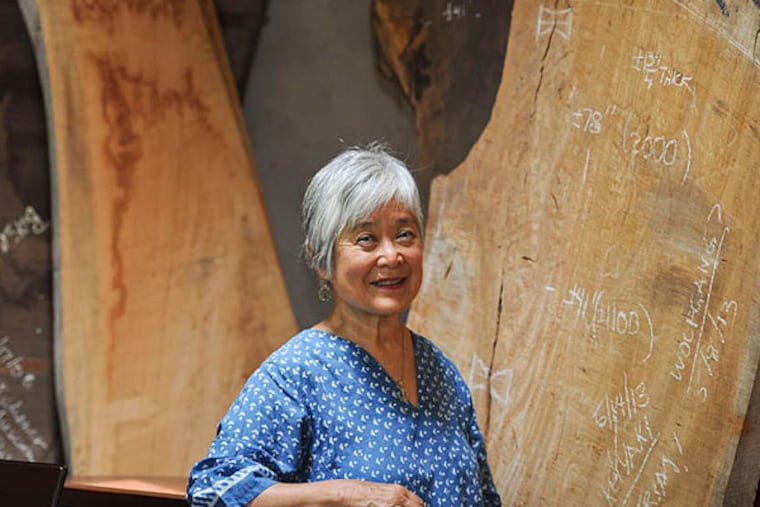Nakashima studio preparing fourth 'peace altar'
When the renowned Bucks County woodworker George Nakashima acquired a stunning, 300-year-old black walnut tree in 1983, he puzzled over exactly what to do with the spectacular wood.

When the renowned Bucks County woodworker George Nakashima acquired a stunning, 300-year-old black walnut tree in 1983, he puzzled over exactly what to do with the spectacular wood.
But then, in a dream, a lofty idea hit the man who had studied woodworking at a World War II internment camp: It should be used to build magnificent altars, all dedicated to peace and sent to the far corners of the world.
The first "Altar for Peace" was dedicated in grand fashion at the Cathedral of St. John the Divine in Manhattan on New Year's Eve 1986, with a thrilled Nakashima, who operated his furniture-making business from a leafy enclave near New Hope, on hand for the celebration.
But he died in 1990 before any more altars could be built. Yet his dream has lived on, thanks largely to his daughter, Mira. Today, there is a peace altar in Russia, one in India, and before long, there should be one at the Desmond Tutu Peace Centre being planned in Cape Town, South Africa.
"It was his dream, and we all need peace in the world," said Mira Nakashima, 71, creative director of her father's woodworking business and president of the foundation established to put a peace table on every continent.
But for now, a giant slab of walnut is ready for finishing at the Nakashima compound in Solebury Township. Mira Nakashima said she was waiting for word, hopefully in the next year or so, that the Tutu center was ready for the table that will emerge from the smooth, dark, 14-foot-long piece of wood.
The wood is typical of what George Nakashima loved: rich grain, raw edges, and unusual markings.
Nakashima, considered one of the foremost 20th-century furniture designers, believed that each tree had a soul and its own character, and that the woodworker should allow the spirit of the wood to come to life. He had an almost X-ray vision to discern the kind of wood that would emerge, said woodworker Gerald Everett, who has worked at the Nakashima studio for more than 40 years.
"He certainly had respect for the wood, the trees, and the vision for what he wanted to do," said Everett, taking a break at the wood shop recently as the shrill sounds of buzz saws pierced the quiet calm.
Born in Washington state in 1905, Nakashima studied forestry and architecture at the University of Washington, earned his master's degree at the Massachusetts Institute of Technology, and became an architect. He traveled to France, India, and Japan before returning to the United States just as World War II was starting.
He and his wife, Marion, and Mira, then a baby, were imprisoned at a Japanese American internment camp in Idaho, where Nakashima made the best of the situation by studying woodworking under a Japanese American carpenter.
"The only thing he ever said to me about the internment is, his wounds healed over and left no scars," his daughter said.
After they were released from the camp with the help of his employer, the architect Antonin Raymond, Nakashima brought his young family to live at Raymond's farm outside New Hope until he bought the parcel of land in nearby Solebury.
For Nakashima, it was the perfect place to build furniture because of the rich supply of trees nearby. His unusual designs slowly gained popularity, with clients such as Vice President Nelson A. Rockefeller, and Nakashima became known for his creativity and attention to detail.
When her father died, Mira Nakashima, who has a master's degree in architecture and had worked for her father, was at first unsure what to do.
But she soon learned her father had been storing caches of wood in Philadelphia and Lehigh County, in addition to what was on hand at their compound. So, with plenty of wood and three years of orders to fill, Mira, her mother, and brother Kevin decided to keep the business running.
"Dad bought all those logs," said Mira Nakashima, who oversees the business even as she works to ensure her father's legacy. "He had something in mind for each part of those trees, and that's his legacy and I can't waste it."
In an interview shortly before the first altar was unveiled, George Nakashima explained how he came up with the idea of what to do with that beautiful walnut.
"In my dream, I saw this tree as a giant table, an altar for peace, which would be an instrument of conciliation, of bringing people together," he told the Princeton Packet in 1986.
He expressed more about his thinking during the New York unveiling.
"It is hoped that this table might become a physical symbol of peace, a peace that is central to our very existence on Earth," he told the crowd of about 5,000, according to a New Hope Gazette article about the dedication.
With help from foundation board members and supporters, two more altars have been installed. Five years after Nakashima's death, the second peace altar was built from that same walnut tree. It was first displayed at the Hague, Netherlands, and now is at the Russian Academy of Art in Moscow.
In 1996, the third table was dedicated in the southern Indian city of Auroville, which was planned as a center for peace and unity and which is close to a spiritual community where George Nakashima refined his own spiritual philosophy.
The challenges were different in each place. "That's the way peace is," Mira Nakashima said.
She acknowledged she could have done all sorts of things to honor her father's memory. But somehow, it was a no-brainer to press forward with his dream of having a peace altar on every continent.
"It just seemed like the right thing to do," she said.
For more information, go to http://www.nakashimawoodworker.com.